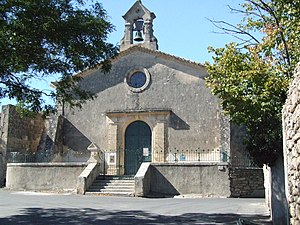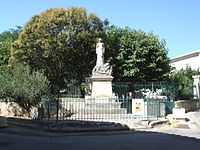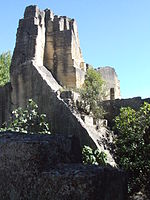Junas
| Junas | ||
|---|---|---|
|
|
||
| region | Occitania | |
| Department | Gard | |
| Arrondissement | Nîmes | |
| Canton | Calvisson | |
| Community association | Pays de Sommieres | |
| Coordinates | 43 ° 46 ′ N , 4 ° 7 ′ E | |
| height | 14-96 m | |
| surface | 7.75 km 2 | |
| Residents | 1,107 (January 1, 2017) | |
| Population density | 143 inhabitants / km 2 | |
| Post Code | 30250 | |
| INSEE code | 30136 | |
| Website | http://www.junas.fr | |
 Protestant Church |
||
Junas is a French commune with 1107 inhabitants (as of January 1, 2017) in the Gard department in the Occitanie region .
geography
Junas is located 20 kilometers southwest of Nîmes and 26 kilometers northeast of Montpellier . The place represents the edge of the Vaunage landscape and is added to it in a broader sense; it is located between the Mediterranean coast in the south and the foothills of the Cevennes, which begins to the north . The municipality is traversed by the Vidourle River and the Corbières and Courchamp streams . The Vidourle forms the communal and département border for a few kilometers to the Hérault département in the south-west .
The neighboring municipalities of Junas are Villevieille in the north, Congénies in the northeast, Aubais in the east, Saint-Sériès in the south, Boisseron in the southwest and Sommières in the west.
Infrastructure
There are connections to neighboring towns via local roads. The regional transport axes D6110 to Alès in the north and the D610 to Montpellier in the south run via Sommières .
Culture and history
history
The current location probably dates back to the 12th century, when it was still a fortress-like complex. It had two entrances that have survived to this day and was secured by provisions such as loopholes on the houses. It was mainly nobles from surrounding towns like Le Cailar and Aubais who ruled Junas. However, the size remained limited, so that the population was limited to five families, i.e. between 20 and 80 people, at a count around the year 1384. In addition, the region was badly hit by the plague wave of 1348/49 and by several famines between 1350 and 1450. In the Middle Ages , agriculture focused on the cultivation of grain, while viticulture remained largely insignificant. In addition, small gardens were used for growing vegetables. In addition, the medieval village had one or two mills in which the local olive harvest was processed. On the other hand, despite the importance of grain cultivation at the time, there is no evidence of a corresponding mill, so that the farmers were dependent on external mills.
In the early modern period , Junas grew beyond its walls and three settlements emerged outside the wall ring. There was an economic boom, as a result of which two butchers, two bars and a blacksmith settled in the town center. Most notably, a flour mill was built on the banks of the Corbières stream in 1482. A few years before the French Revolution , which began in 1789 , the entire region was hit by an economic crisis, which led to a corresponding rejection of the Ancien Régime during the revolution. After a ship with 69 Republican soldiers sank in the Rhône on March 26, 1792 , Junas and several neighboring towns became the scene of uprisings and acts of violence, as the responsibility for the incident was attributed to the royalists loyal to the king. In 1794, the hamlet of Gavernes , which lies south of the town center and had been an independent municipality from 1790 on, was incorporated into Junas.
When the rail connection between Lunel and Ganges was established in 1870 , Junas received a station on the new route. This was one and a half kilometers away from the town and had to wait until 1875 for rail traffic to start. In 1886 it was replaced by a second station, which was 500 meters away from Junas and also had Aujargues a few kilometers to the north in its name.
Buildings
Since Junas belongs to a region in strongly Catholic France, in which the Protestant minority is strongly represented, the place has a church of the latter denomination. During a phase in which the Protestants suffered particularly from persecution, the original building fell victim to the Catholic opponents on August 20, 1685 and was destroyed. It was rebuilt in 1820 and the bell tower was added towards the end of the 19th century. Its construction was completed with the dedication of the bell that was cast in 1897. In addition to fulfilling religious tasks, the religious building is also a venue for artistic and musical events. Various renovations were carried out in 2013.
The existence of a Catholic church in the village has been documented since the middle of the 12th century. Because it had gotten into a very poor structural condition over time, it was rebuilt between 1680 and 1686. In 1693 it was set on fire by the Huguenot camisards , but was largely preserved. After the Protestant Church was destroyed in 1685, the former Catholic Church temporarily adopted the other denomination from 1703 onwards. In 1772, the building's bell was removed and replaced in the village clock tower. After 50 years without a bell, the church was given a new one in 1822.
The clock tower in the center of the village was built in 1772 and was equipped with the church bell when it was built. In 1927 it was largely destroyed by a lightning strike and rebuilt from 1928 to 1929. The clock itself and its mechanism date from 1880. Another important historical element are the remains of the medieval protective walls, which in many cases were integrated into the houses. In the surrounding area, the remains of the mill from the late 15th century have been preserved. The building, which was closed in 1850, has belonged to the municipality since 2005.
Junas quarries
Outside the village center there are several stone quarries, the founding of which dates back to the early phase of the Roman occupation beginning around 120 BC. They are called carrières du Bon Temps , which goes back to their location in the low-lying area called Bon Temps . In the approximately 2000 years of their existence, the quarries have become suppliers for urban development in places such as Le Vigan , neighboring Sommières and Aigues-Mortes , where the stones from Junas make up part of the city fortifications. Presumably they belonged to the respective lord of the place during the feudal period before they passed into the possession of the commune during the French Revolution . It is certain that the municipal administration leased it to the highest bidder in 1845. Although the exact intensity of use in the various epochs is largely in the dark, a document from 1868 shows that there were 40 permanent workers in the quarries at that time and the annual output was an estimated 12,000 tons. After the business was closed in the middle of the 20th century, they now serve as a local recreation area and offer space for cultural events.
Based on the quarries, so-called rencontres de la Pierre (stone meetings) take place annually, which are sporting games related to local stone production. In 2003, the idea to build a pavilion was born. This was constructed over the following years and inaugurated in 2011. It contains five arches and a stone dome, reaches a height of four meters with a weight of 35 tons and bears the name kiosque de Junas .
Culture
Since 1993 Junas has hosted a jazz festival that takes place every year in the third week of July. On the first weekend in June, the village's patronage festival is celebrated, including a bull run . In addition, there is a sports club of its own, which especially offers football for children. Every year on May 1st, a sports day organized by the community is held.
Population development
| year | 1962 | 1968 | 1975 | 1982 | 1990 | 1999 | 2010 | 2017 |
|---|---|---|---|---|---|---|---|---|
| Residents | 316 | 321 | 363 | 518 | 648 | 721 | 1089 | 1107 |
In 1793 the community was inhabited by 580 people. The number experienced fluctuations in the following period, but remained roughly at its level with 548 inhabitants in 1901. At the beginning of the 20th century, however, there was a decline in population, which increased with the Second World War , so that in 1946 only 361 residents were recorded. In the 1970s, there was a trend reversal towards strong growth, as a result of which the number multiplied within a few decades and exceeded the 1000-inhabitant mark a few years after the beginning of the 21st century.
Personalities
The writer and philosopher Jean-Paul Sartre , who died in 1980, spent several vacations in Junas in the 1970s, where his adopted daughter Arlette Elkaïm-Sartre owned a house.
Web links
Individual evidence
- ↑ Mairie de Junas , annuaire-mairie.fr
- ↑ Histoire ancien , forum.junas.info
- ↑ l'histoire de Junas , junas.fr
- ↑ a b Junas - Notice Communale , cassini.ehess.fr
- ↑ le petit patrimoine de Junas , junas.fr
- ↑ Junas Le temple profite des travaux d'embellissement pour briller de mille feux , midilibre.fr
- ↑ le patrimoine de Junas , junas.fr
- ↑ Les carrières , forum.junas.info
- ↑ les carrières de Junas , junas.fr
- ↑ Le kiosque ( page no longer available , search in web archives ) Info: The link was automatically marked as defective. Please check the link according to the instructions and then remove this notice. , rencontresdelapierre.org
- ↑ manifestations annuelles à Junas , junas.fr
- ↑ Les associations de Junas , junas.fr
- ↑ Jazz à Junas - Musiques , telerama.fr
- ↑ Biography of Sartre (PDF; 406 kB), sartre.ch, page 34



